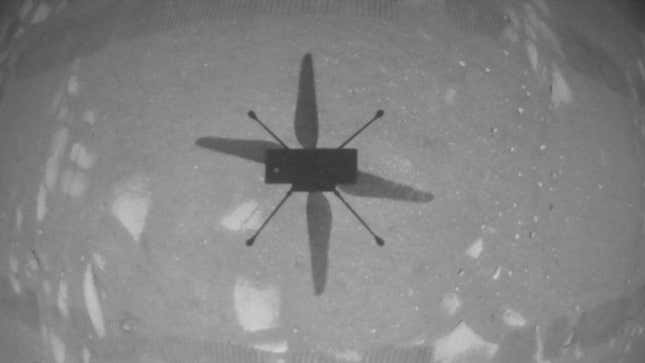
NASA’s Ingenuity helicopter just took its first flight on Mars. It’s the first powered, controlled flight on another planet. Ingenuity completed the flight carrying a small piece of one of Orville and Wilbur Wright’s original aircrafts tucked under its blades, in a nod to the legacy that made this morning’s achievement possible.
NASA is hosting a press conference at 2:00 p.m. ET to share more about today’s flight. You’ll be able to watch it live at the stream below.
Ingenuity’s momentous hover over the Red Planet was autonomous; the craft is not controlled by any joystick on Earth, but by the computers aboard the craft. The helicopter, which journeyed to Mars strapped to the belly of the Perseverance rover, harbors no scientific instruments. It is an experimental craft designed by NASA, tasked with establishing a precedent for future flight on other planets, with differing atmospheres and gravitational pulls than our own. (On Mars, the atmosphere is 1% as thick as Earth’s, and the pull of gravity there is about one-third what it is on Earth.) Ingenuity just passed that test with flying colors and has at least four more flights on its docket before the $85 million machine is retired.
Ingenuity is a 4-pound helicopter that is made up by four spindly legs, a box (which contains its computers), and two counter-rotating blades to actually get the machine off the ground. The carbon fiber blades are light—each about as heavy as a lightbulb—to minimize the weight the machine is trying to lift. To work with that thin Martian atmosphere, the helicopter’s rotors are spinning at over 2,500 rpm. The flight lasted about 40 seconds and took place at 3:46 a.m. ET.
A NASA team was monitoring the helicopter from mission control, checking to see if anything was amiss. In their preparation for the flight, the helicopter’s rotors had some timing issues—the sort of thing that could put a multi-million dollar aircraft in jeopardy, even if just 10 feet off the ground. The crew changed some of the commands they were giving the helicopter, which they hoped would fix the problem. The team didn’t know of the attempt’s success for another three hours, when the data from the flight finally downlinked to Earth.
Update: This article previously stated that this feat was “not even attempted during the mid-century heyday of the Moon landings.” As our commenters note, it of course makes sense that no such flight was attempted on the Moon, given its lack of an atmosphere.

